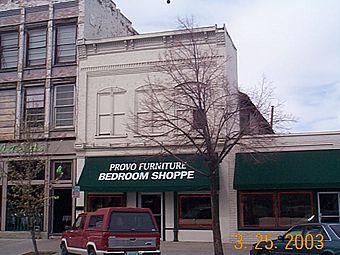Provo West Co-op facts for kids
Quick facts for kids |
|
|
Provo West Co-op
|
|

Provo West Co-op
|
|
| Location | 466 West Center Street Provo, Utah |
|---|---|
| Area | less than one acre |
| Built | c.1866, c.1890 |
| Architectural style | Early Commercial |
| NRHP reference No. | 84002429 |
| Added to NRHP | July 13, 1984 |
The Provo West Co-op is a historic building in Provo, Utah, that used to be a special kind of store. It was built in an Early Commercial style. This important building was added to the National Register of Historic Places in 1984. It is also recognized as a historic landmark by Provo City.
Contents
Why Was the Provo West Co-op Built?
The Provo West Co-op was one of the first stores built in Provo as part of a "cooperative" movement. This movement was supported by The Church of Jesus Christ of Latter-day Saints in the late 1800s. The idea was to help people trade goods fairly among themselves.
Early Trading in Provo
The city of Provo, Utah was settled by members of the LDS church in 1849. At first, most people in Provo were farmers. They grew food but needed other supplies. These goods often came from Salt Lake City and were traded for food.
In 1853, Andrew J. Stewart opened Provo's first store in his home. Later, in 1869, a store he built on Center Street became the Provo West Co-op.
During the 1860s, merchants in Utah were making a lot of money. However, farmers and the LDS church members, who relied on farming, didn't make much profit. This made them unhappy with the merchants' success.
Brigham Young, who was the President of the LDS church at the time, told church members to "stop paying very high prices from people who didn't care about them." He believed that people could save a lot of money each year if they traded differently.
An effort was made to lower the price of flour for church members. A group called the Utah Produce Co. was formed. They hoped to buy all the grain in the area and then control the price of flour. But this plan didn't last long and failed.
When the railroad started coming to Utah, many members of The Church of Jesus Christ of Latter-day Saints worried. They feared that more outsiders would come and make even bigger profits from them.
Starting the Cooperative Stores
Samuel S. Jones and David John were the first to act. They wanted to build a cooperative trading store. In December 1868, they made plans for the store. People pledged money, and by the end of the month, they had $17,000.
The first cooperative store was bought from H.W. Lawrence. He sold his goods and building at a fair price. This store became known as the "East Co-op."
Then, it was suggested that the women of the Relief Society, which is the women's organization in the LDS church, should also be part of the cooperative system. The women agreed! On March 24, 1869, they met to plan how they could help.
They first thought about building four stores, one for each area of Provo. But they decided to start with one store until they had enough money to grow. They bought the building that Andrew Stewart had built in 1869 on Center Street. Samuel S. Jones became its manager. This store was first called the "Female Store" or the "Women's Co-op," but it eventually became known as the "West Co-op."
After the cooperative trading system was set up in Provo, Brigham Young convinced merchants in Salt Lake City to join in. This led to the creation of the Zion's Cooperative Mercantile Institution (Z.C.M.I.). This meant that goods could be bought from Z.C.M.I. and then sold in the Provo stores.
How the Co-ops Succeeded
Both the East and West Cooperative Mercantile Institutions did very well financially. The West Co-op did even better because its goods were brought in by railroad, which made them cheaper. After about three months, the West Co-op had made $254.15 in profit. They paid out good returns to their members, between twenty and thirty percent!
Because of this success, more cooperative stores were started in Provo. These included a Boot and Shoe Store, a Pottery, Woolen Mills, a Meat Market, a Grist Mill (for grinding grain), a Brick company, a Stock-herd, a Drug Store, and a Clothing and Tailoring Store.
The Building's Look
The Provo West Co-op building is in the Early Commercial style. It has two stories and a flat roof, with an outside made of brick. The inside of the building, made of wood and adobe, was built around 1866. The brick exterior was added around 1890 by the Provo West Co-op before it closed down.
Today, the two-story painted brick building is still in good shape. The entrance has tall, round columns called Tuscan columns. The windows on the second floor are double-hung sash windows, showing a style called Victorian Eclectic. Details like dentils (small block shapes) and consoles (decorative brackets) are lined up neatly on the top edge of the building. Even though some changes have been made over time, the building still looks a lot like it did in the late 1800s.
- Historic Provo. 2002 Provo City Landmarks Commission. (The address is listed as 450 West Center in this publication as well as in the National Register nomination).



